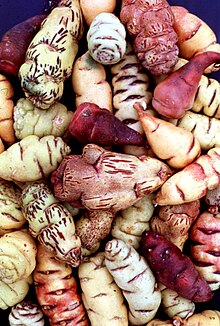Tropaeolum tuberosum
| Mashua | |
|---|---|
 |
|
| Various mashua tubers of different shapes and pigmentations | |
| Scientific classification | |
| Kingdom: | Plantae |
| (unranked): | Angiosperms |
| (unranked): | Eudicots |
| (unranked): | Rosids |
| Order: | Brassicales |
| Family: | Tropaeolaceae |
| Genus: | Tropaeolum |
| Species: | T. tuberosum |
| Binomial name | |
|
Tropaeolum tuberosum Ruíz and Pavón |
|
Tropaeolum tuberosum (mashua, see below for other names) is a species of flowering plant in the family Tropaeolaceae, grown in the Andes, particularly in Peru and Bolivia, and to a lesser extent in Ecuador as well as in Boyacá Department, Colombia, for its edible tubers, which are eaten cooked or roasted as a vegetable. It is a minor food source, especially to native Amerindian populations. Mashua is a herbaceous perennial climber growing to 2–4 m (7–13 ft) in height. It is related to garden nasturtiums, and is occasionally cultivated as an ornamental for its brightly coloured tubular flowers.
This plant is commonly called mashua in Peru and Ecuador, but other names include:
The plant grows vigorously even in marginal soils and it competes well with weeds. It is well-adapted to high-altitude subsistence agriculture, and gives high yields; 30 tonnes per hectare are yielded at a height of 3000 metres, but up to 70 tons per hectare have been produced under research conditions. Its extraordinary resistance to insect, nematode and bacterial pests is attributed to high levels of isothiocyanates. Although mashua is fully domesticated, it can persist in wild vegetation because of its aggressive growth and robustness. In Colombia, it is planted as a companion crop to repel pests in potato fields.
The tuber is pungent in flavor when raw, but this quality disappears when cooked. The tubers comprise as much as 75 percent of the mature plants by dry weight (40 percent is typical for cereals). Up to 75 percent of dry matter reaches the tubercle.
Popularization of mashua may be limited by its strong flavor, and its reputation as an anaphrodisiac. However, mashua tubers roasted in traditional earthen field ovens, built at harvest, are considered a delicacy. Also, the raw tubers can be shredded thinly and added to salads, to confer a spicy flavour and crunchy texture.
...
Wikipedia
